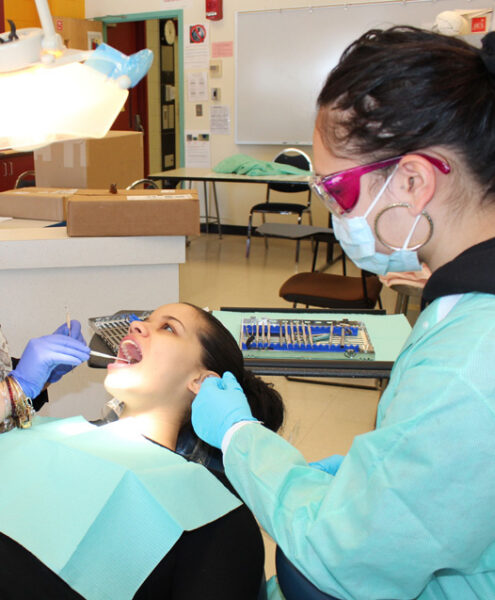Dental Assisting 10th grade is a performance-based course. Emphasis is placed on procedures for which the dental assistant is directly responsible. Foundation knowledge and skills acquired during freshman year will be built upon. The students practice procedures performed in general dentistry. In order to prepare for The Dental Assisting National Board Infection Control Certification, Infection Control and Health and safety practices will be a large part of this year’s instruction. This course includes; instrument processing and sterilization methods, biological monitoring, intermediate-level surface disinfection, universal standard precautions, monitoring patient vital signs, donning personal protective equipment, syringe assembly, intraoral topical placement, utilization of tray setups for general practice, Tofflemire matrix assembly, handpiece, and rotary instrument care, instrument transfer, moisture control, dental dam application, restorative materials and procedures, manipulation of dental cement, preventative measures, custom tray fabrication, vacuum forming, study casts, bite registrations, and introduction to dental radiography radiation safety. Employability and accountability skills are expected, requiring students to be in school uniform or shop top on prescribed days or events. Students receive certification in CPR Healthcare provider level. Students learn hands-on procedures in a simulated dental environment.
The Principles of Dental Assisting is theory instruction intended to complement the vocational instruction and laboratory projects taught during the sophomore year. This course will cover topics in; understanding the embryonic development and histology of the skull and dentition; functions of bodily systems; the characteristics and functions of human dentition; and tooth morphology. Students also receive instruction in maintaining dental patient records, manual dental charting, dental instrumentation, chairside techniques, and responding to client needs. Education in the areas of dental material recognition includes gypsum properties and manipulation, alginate properties and manipulation, amalgam materials, composite materials, dental waxes, foundations of dental cement, and dental terminology. All aspects of infection control needed by dental healthcare workers to conduct themselves efficiently and safely in the workplace are instilled. Education in the areas of; management and selection of personal protective equipment; strategies to prevent disease transmission; theory instruction on dental instrument care, instrument processing, and sterilization techniques; surface disinfection solutions and active ingredients; and aseptic techniques are reinforced. Occupational safety; hazard communication standards and quality assurance procedures; selection of safety devices; and immunization of healthcare workers are covered.
The focus is on preparing the student for the Dental Assisting National Board Infection Control exam. The areas of education and training in this section will also include microbiology, dental unit water asepsis, management and interpretation of SDS sheets, management of hazardous materials, dental waste disposal, a comprehensive study of Bloodborne pathogens and the OSHA Bloodborne Pathogen Standard, emerging diseases, oral and respiratory disease prevention, and CDC prevention guidelines for infection control in a dental health care setting. Career
portfolios are updated throughout the school year.
